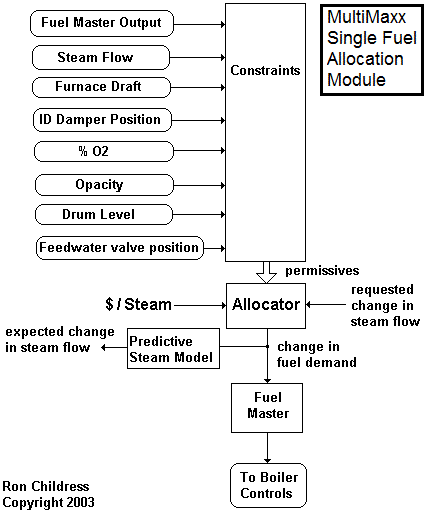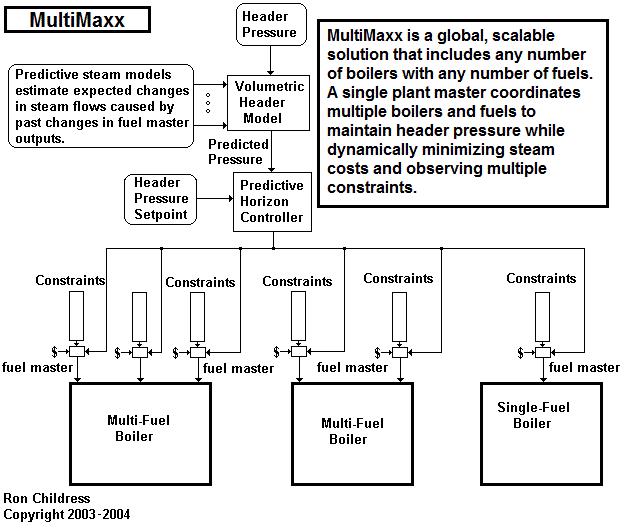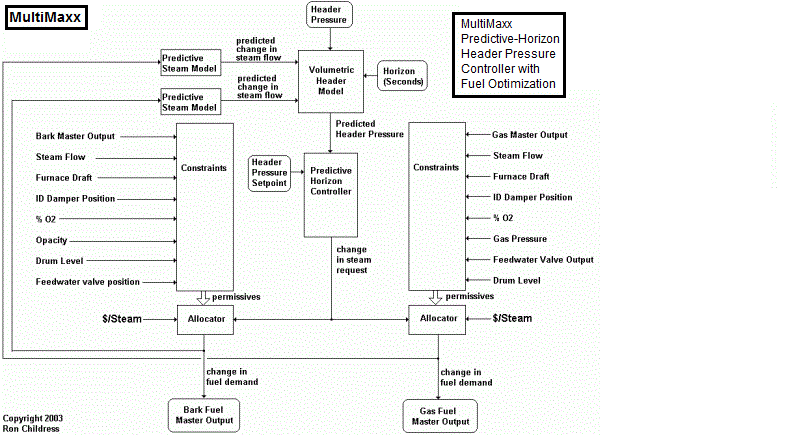
| MultiMaxx Predictive-Horizon Header Pressure Control With Embedded Fuel Optimizer Operational Theory |
Ronald L. Childress, Jr.
Director of R & D
Dynamic Energy Systems, LLC
November 7, 2003
MultiMaxx Overview
MultiMaxx is an exciting breakthrough in control technology that solves many obstacles faced by modern power house
operations. This advanced control solution is producing incredible savings at several installations across North America.
MultiMaxx maintains header pressure to a single setpoint with one or more boilers, while continuously minimizing the cost of
steam generation and observing multiple constraints. Any number of boilers are supported with any number of fuels.
Director of R & D
Dynamic Energy Systems, LLC
November 7, 2003
MultiMaxx Overview
MultiMaxx is an exciting breakthrough in control technology that solves many obstacles faced by modern power house
operations. This advanced control solution is producing incredible savings at several installations across North America.
MultiMaxx maintains header pressure to a single setpoint with one or more boilers, while continuously minimizing the cost of
steam generation and observing multiple constraints. Any number of boilers are supported with any number of fuels.
Figure 1. MultiMaxx Global and Scalable Optimization Solution
Every second, MultiMaxx determines the best use of boiler and fuel resources to maintain header pressure. Multiple
constraints for each boiler are monitored to stay within predefined operating envelopes. Typical constraints include, but are not
limited to: minimum and maximum steaming limits, furnace draft limits, drum level and drum level stability limits, fuel pressure
and flow limits, damper positions, %O2, opacity, particulate, etc...
The control system changes objectives, depending on process conditions. During times of steady steam demand, MultiMaxx
works to minimize overall cost of steam. But, during process upsets, MultiMaxx abandons absolute economy for robust
control. Since there is a compromise between robust control and economy, the owner chooses how much economy to forfeit
for better performance.
For example, consider controlling header pressure with bark and fossil fuel. Typically, the response time to increase steam
generation with an increase in bark flow is ten minutes. Response time to increase steam generation by increasing fossil fuel
flow is two minutes. In this case, fossil fuel can control header pressure about five times better than bark for a given
disturbance.
At many sites, bark is essentially free fuel and fossil fuel is very expensive. Obviously, the goal is to maximize bark fuel and
minimize fossil fuel consumption. Unfortunately, header pressure control can be no tighter than the fastest responding steam
producer for a given disturbance.
More robust header pressure control is obtained using the faster response of fossil fuel, but at a much high cost. Using only
low cost bark, the header pressure may sag below acceptable limits during an increase in steam demand due to longer
response times.
A compromise is to use fossil fuel to maintain header pressure, but only while waiting for bark produced steam to respond. As
more bark steam is produced, fossil fuel is returned to a minimum.
Overall cost of steam using this strategy is more expensive than controlling with only bark. But, overall steam cost is much
less expensive than using only fossil fuel. In this case, the system is tuned for the largest acceptable variation in header
pressure to minimize overall steam cost. How much variation is acceptable is managed with MultiMaxx "Economy vs
Performance" adjustment.
To improve performance even more, MultiMaxx incorporates a predictive horizon header pressure controller. Instead of
controlling to instantaneous header pressure, the system adjusts boiler loads to maintain a predicted header pressure several
minutes into the future. This strategy is analogous to driving a car while looking down the road, instead of looking just over the
hood. This prevents boilers from over responding to process upsets due to boiler response lags.
The dead-time and first order response of each boiler is determined empirically by performing on-line bump tests. These boiler
characteristics are recorded and used by MultiMaxx to predict changes in future steam production from past changes in fuel
master outputs. Additional bump tests determine the volumetric characteristics of the steam header system.
Conventional plant masters are adversely affected by lag times induced by steam header volume. The larger the header
volume, the more conventional pressure control suffers. To overcome header pressure lags, conventional pressure controller
gain must be reduced to prevent header pressure oscillations.
Unlike conventional controls, MultiMaxx actually takes advantage of the header's storage capacity! The header's lag time is
used to offset the boiler's response time to obtain the tightest header pressure control possible. For MultiMaxx, the bigger the
header volume, the better it works.
Also, by understanding volume characteristics and watching changes in header pressure, MultiMaxx calculates the change in
steam flow required to balance overall steam demand. Essentially, MultiMaxx uses the header as a steam flow balance
indicator. This eliminates the need to measure multiple steam flows required for conventional boiler feed-forward controls.
Once the steam flow imbalance is determined, a request for a change in steam demand is sent to all boiler fuel allocators. The
total request is divided among the different boiler fuel masters based on boiler size, cost of steam and boiler fuel availability.
Cost of steam is determined from fuel costs and incremental boiler efficiencies. Availability is determined by the boiler fuel
masters selected for header pressure control and the boilers operating inside normal constraint boundaries. Additional
constraints are added easily, as needed. Constraints can also be quickly bypassed, if necessary.
MultiMaxx adjusts fuel master outputs with the understanding that it's going to take a while to actually get more steam. It's
also understood that each fuel and boiler have different response times and characteristics. Unlike conventional header
pressure systems that continually requests for more and more steam during an upset, MultiMaxx simply waits for boilers to
produce the additional steam needed, even if the header pressure continues to fall.
Controlling more like an Operator, MultiMaxx sees a change in header pressure, makes an adjustment, waits, then tweaks.
The result is outstanding header pressure control at substantially reduced fuel costs. Thermal stress is reduced because
boilers no longer over respond to header pressure deviations. Also, multiple boilers can participate in maintaining header
pressure, so one boiler does not have to shoulder the entire load swing. It's another economic versus performance decision
made by the system owner.
MultiMaxx supports a unique messaging system that informs Operators in plain English of encountered constraints and status
information. MultiMaxx clearly explains why boilers are constrained and not taking action to maintain header pressure set
point. A typical message may read, "Boiler 5 can not increase hog steaming because ID Fan is maximized". Special reports
are available to consolidate daily constraint information to identify ways to improve savings through process improvements.
MultiMaxx consists of a set of scalable modules that combine to create a powerful, global power house solution. MultiMaxx
controls all boilers and fuels to a single header pressure setpoint for the entire power house. Gone are the days of biasing
setpoints of multiple pressure controllers! A modular set of control algorithms reside in the regulatory control platform as an
integral part of the boiler's combustion controls. Modular integration into the basic controls provides an extremely robust and
reliable solution that set's MultiMaxx years ahead of the competition.
Every second, MultiMaxx determines the best use of boiler and fuel resources to maintain header pressure. Multiple
constraints for each boiler are monitored to stay within predefined operating envelopes. Typical constraints include, but are not
limited to: minimum and maximum steaming limits, furnace draft limits, drum level and drum level stability limits, fuel pressure
and flow limits, damper positions, %O2, opacity, particulate, etc...
The control system changes objectives, depending on process conditions. During times of steady steam demand, MultiMaxx
works to minimize overall cost of steam. But, during process upsets, MultiMaxx abandons absolute economy for robust
control. Since there is a compromise between robust control and economy, the owner chooses how much economy to forfeit
for better performance.
For example, consider controlling header pressure with bark and fossil fuel. Typically, the response time to increase steam
generation with an increase in bark flow is ten minutes. Response time to increase steam generation by increasing fossil fuel
flow is two minutes. In this case, fossil fuel can control header pressure about five times better than bark for a given
disturbance.
At many sites, bark is essentially free fuel and fossil fuel is very expensive. Obviously, the goal is to maximize bark fuel and
minimize fossil fuel consumption. Unfortunately, header pressure control can be no tighter than the fastest responding steam
producer for a given disturbance.
More robust header pressure control is obtained using the faster response of fossil fuel, but at a much high cost. Using only
low cost bark, the header pressure may sag below acceptable limits during an increase in steam demand due to longer
response times.
A compromise is to use fossil fuel to maintain header pressure, but only while waiting for bark produced steam to respond. As
more bark steam is produced, fossil fuel is returned to a minimum.
Overall cost of steam using this strategy is more expensive than controlling with only bark. But, overall steam cost is much
less expensive than using only fossil fuel. In this case, the system is tuned for the largest acceptable variation in header
pressure to minimize overall steam cost. How much variation is acceptable is managed with MultiMaxx "Economy vs
Performance" adjustment.
To improve performance even more, MultiMaxx incorporates a predictive horizon header pressure controller. Instead of
controlling to instantaneous header pressure, the system adjusts boiler loads to maintain a predicted header pressure several
minutes into the future. This strategy is analogous to driving a car while looking down the road, instead of looking just over the
hood. This prevents boilers from over responding to process upsets due to boiler response lags.
The dead-time and first order response of each boiler is determined empirically by performing on-line bump tests. These boiler
characteristics are recorded and used by MultiMaxx to predict changes in future steam production from past changes in fuel
master outputs. Additional bump tests determine the volumetric characteristics of the steam header system.
Conventional plant masters are adversely affected by lag times induced by steam header volume. The larger the header
volume, the more conventional pressure control suffers. To overcome header pressure lags, conventional pressure controller
gain must be reduced to prevent header pressure oscillations.
Unlike conventional controls, MultiMaxx actually takes advantage of the header's storage capacity! The header's lag time is
used to offset the boiler's response time to obtain the tightest header pressure control possible. For MultiMaxx, the bigger the
header volume, the better it works.
Also, by understanding volume characteristics and watching changes in header pressure, MultiMaxx calculates the change in
steam flow required to balance overall steam demand. Essentially, MultiMaxx uses the header as a steam flow balance
indicator. This eliminates the need to measure multiple steam flows required for conventional boiler feed-forward controls.
Once the steam flow imbalance is determined, a request for a change in steam demand is sent to all boiler fuel allocators. The
total request is divided among the different boiler fuel masters based on boiler size, cost of steam and boiler fuel availability.
Cost of steam is determined from fuel costs and incremental boiler efficiencies. Availability is determined by the boiler fuel
masters selected for header pressure control and the boilers operating inside normal constraint boundaries. Additional
constraints are added easily, as needed. Constraints can also be quickly bypassed, if necessary.
MultiMaxx adjusts fuel master outputs with the understanding that it's going to take a while to actually get more steam. It's
also understood that each fuel and boiler have different response times and characteristics. Unlike conventional header
pressure systems that continually requests for more and more steam during an upset, MultiMaxx simply waits for boilers to
produce the additional steam needed, even if the header pressure continues to fall.
Controlling more like an Operator, MultiMaxx sees a change in header pressure, makes an adjustment, waits, then tweaks.
The result is outstanding header pressure control at substantially reduced fuel costs. Thermal stress is reduced because
boilers no longer over respond to header pressure deviations. Also, multiple boilers can participate in maintaining header
pressure, so one boiler does not have to shoulder the entire load swing. It's another economic versus performance decision
made by the system owner.
MultiMaxx supports a unique messaging system that informs Operators in plain English of encountered constraints and status
information. MultiMaxx clearly explains why boilers are constrained and not taking action to maintain header pressure set
point. A typical message may read, "Boiler 5 can not increase hog steaming because ID Fan is maximized". Special reports
are available to consolidate daily constraint information to identify ways to improve savings through process improvements.
MultiMaxx consists of a set of scalable modules that combine to create a powerful, global power house solution. MultiMaxx
controls all boilers and fuels to a single header pressure setpoint for the entire power house. Gone are the days of biasing
setpoints of multiple pressure controllers! A modular set of control algorithms reside in the regulatory control platform as an
integral part of the boiler's combustion controls. Modular integration into the basic controls provides an extremely robust and
reliable solution that set's MultiMaxx years ahead of the competition.
Figure 2. MultiMaxx Single Fuel Allocation Module
Figure 2 shows a single fuel allocator which accepts requests for more or less steam from a header pressure controller. This
module determines how much of the total steam flow request to allocate to the connected fuel master. How much to allocate
is determined by the cost of the fuel, the efficiency and size of the boiler and multiple constraints. The allocator is not allowed
to participate in header pressure control, if the boiler is completely constrained in the direction requested.
Figure 2 shows a single fuel allocator which accepts requests for more or less steam from a header pressure controller. This
module determines how much of the total steam flow request to allocate to the connected fuel master. How much to allocate
is determined by the cost of the fuel, the efficiency and size of the boiler and multiple constraints. The allocator is not allowed
to participate in header pressure control, if the boiler is completely constrained in the direction requested.
Figure 3. MultiMaxx Shown Connected to a Two-Fuel Boiler
As constraints are approached, the amount of requested change to the fuel master is proportionally reduced. This action
smoothly slows the boiler down as a constraint is approached to prevent moving past the constraint. If a constraint is violated,
the allocator adjusts the fuel master to move the boiler back inside all constraint boundaries, even if in opposition to header
pressure control. The remaining boilers on control are allocated more of the load to make up for the counter moves imposed by
the constraints.
Most power houses limit boilers to a maximum steaming rate. Usually, the real limit is not steam flow but something else,
like: furnace draft, superheater velocity, feedwater flow, etc. By observing multiple constraints, boilers can be pushed to a real
limit, instead of an artificial limit. Pushing a boiler to constraint limits reduces an expensive comfort zone that is commonly
found at most power house facilities. Reducing the comfort zone translates into big savings.
Figure 3 shows how individual fuel allocation modules are combined to produce a control system for a single, multi-fuel boiler.
Figure 1 shows each boiler's controls combined into a global, MultiMaxx solution.
Usually, boiler controls are segregated into different controllers. When peer to peer communication between controllers is not
available, MultiMaxx is typically located in a higher, supervisory computer system to gain access to all information and
outputs needed. In the event of a supervisory computer failure, each boiler is designed to shed gracefully back to individual
boiler header pressure control. Predictive header pressure control is still achieved locally with boiler constraints and fuel
optimization intact. However, pressure setpoints between boilers must be staggered to prevent header pressure oscillations.
MultiMaxx is truly the next generation in boiler controls. Embedding fuel optimization directly into the header pressure controls
provides very high performance, unmatched by other optimization schemes. Combined with multiple constraints and English
diagnostic messaging, MultiMaxx provides a comprehensive solution for global power house optimization.
As constraints are approached, the amount of requested change to the fuel master is proportionally reduced. This action
smoothly slows the boiler down as a constraint is approached to prevent moving past the constraint. If a constraint is violated,
the allocator adjusts the fuel master to move the boiler back inside all constraint boundaries, even if in opposition to header
pressure control. The remaining boilers on control are allocated more of the load to make up for the counter moves imposed by
the constraints.
Most power houses limit boilers to a maximum steaming rate. Usually, the real limit is not steam flow but something else,
like: furnace draft, superheater velocity, feedwater flow, etc. By observing multiple constraints, boilers can be pushed to a real
limit, instead of an artificial limit. Pushing a boiler to constraint limits reduces an expensive comfort zone that is commonly
found at most power house facilities. Reducing the comfort zone translates into big savings.
Figure 3 shows how individual fuel allocation modules are combined to produce a control system for a single, multi-fuel boiler.
Figure 1 shows each boiler's controls combined into a global, MultiMaxx solution.
Usually, boiler controls are segregated into different controllers. When peer to peer communication between controllers is not
available, MultiMaxx is typically located in a higher, supervisory computer system to gain access to all information and
outputs needed. In the event of a supervisory computer failure, each boiler is designed to shed gracefully back to individual
boiler header pressure control. Predictive header pressure control is still achieved locally with boiler constraints and fuel
optimization intact. However, pressure setpoints between boilers must be staggered to prevent header pressure oscillations.
MultiMaxx is truly the next generation in boiler controls. Embedding fuel optimization directly into the header pressure controls
provides very high performance, unmatched by other optimization schemes. Combined with multiple constraints and English
diagnostic messaging, MultiMaxx provides a comprehensive solution for global power house optimization.
| Copyright © 2023 Dynamic Energy Systems |



